Australian Iron & Steel
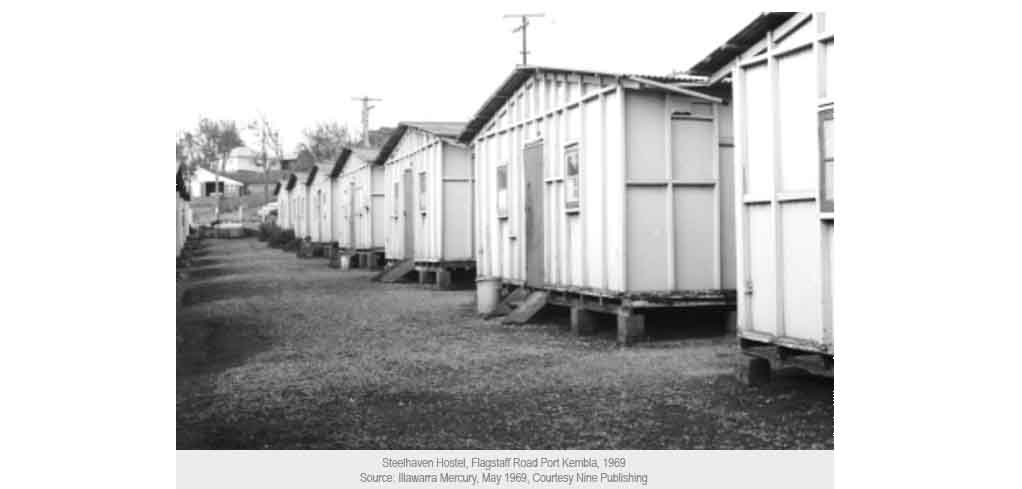
In 1949 when AI&S was operating and expanding their own company workers’ accommodation that was Karingal Hostel, it also needed to establish another hostel in the locality for its migrant workers. There was still insufficient accommodation available at the Commonwealth Hostel at Unanderra to house these migrants most of whom, in the very early days of Unanderra Hostel, were displaced persons. In 1947, when AI&S submitted its plan to build Karingal, one of the sites Council had recommended was that on the eastern side of the works at Steelhaven near the existing temporary barracks for Concrete Constructions Ltd and Spoonerville. The temporary barracks were wedged between the then Shellharbour Road and King Street Warrawong. Instead, AI&S would go on to build Karingal Hostel on the corner of Five Islands Road and Springhill Road in Cringila. However, the alternative site near Concrete Constructions and Spoonerville would be where AI&S would operate Steelhaven Hostel.
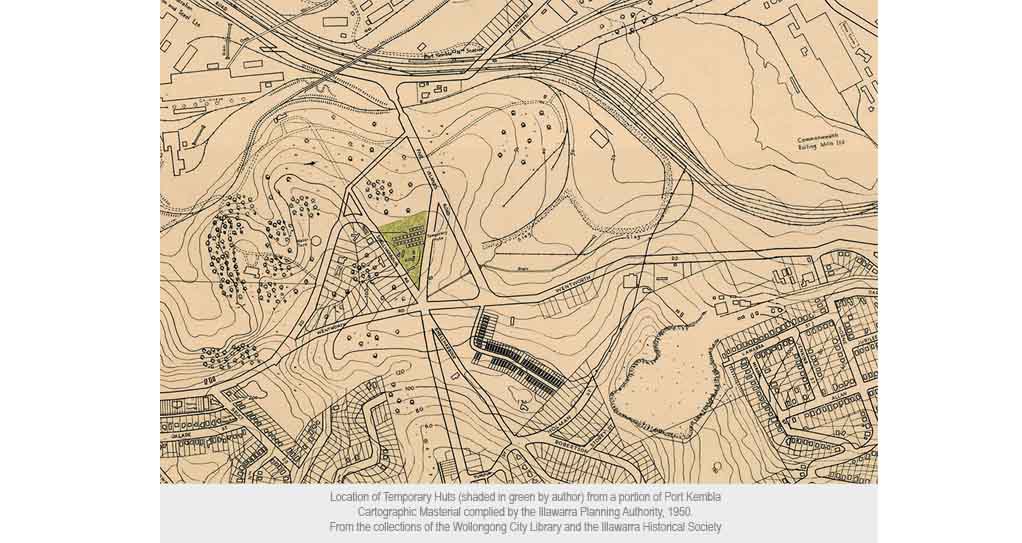
During the depression the area nearby the future Steelhaven Hostel site was known for its shanty towns and humpies that were erected by unemployed people, using any material they could find including kerosene tins. One such shanty town included Flinders Street near the Steelwork coke ovens. Hoskins was shocked at the conditions he saw first-hand in Flinders Street and so arranged to have the empty offices and sheds from the old Lithgow works relocated for use as housing for any of his employees living in Flinders Street. In 1931 AI&S subdivided land at its Port Kembla works and called it Steelhaven. It was there AI&S erected 20 houses with 3 or 4 rooms on blocks measuring 250 feet x 50 feet, ploughed and fenced. It was primarily for AI&S unemployed workers but anyone could apply for housing. Up to 27 houses were built at what was known as ‘Steelhaven Emergency Settlement’. The site of Steelhaven Emergency Settlement is still known as Steelhaven today and was where the AI&S garage was located. Nearby ‘Spoonerville’ would be built by the Government in response to emergency housing requirements during the depression replacing the shanty towns such as that existed in Flinders Street near the coke ovens.
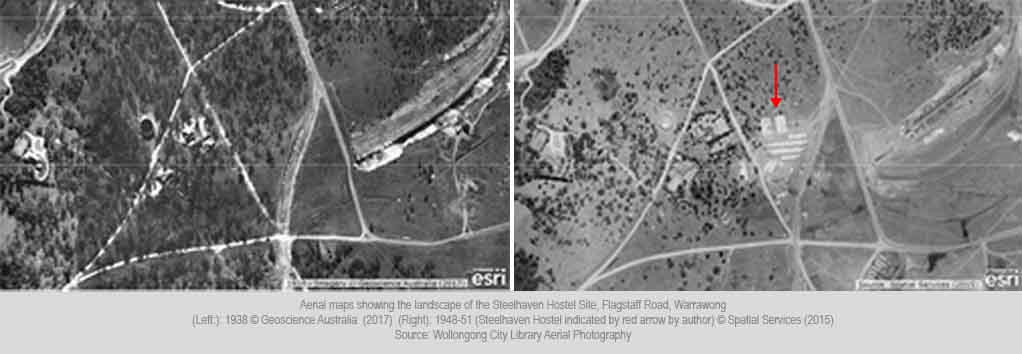

In 1950 when a visit was undertaken by BHP staff the report of the visit stated that Steelhaven Hostel was originally an army camp. After World War 2 Concrete Constructions Ltd used the camp as temporary barracks for their employees who were working on contract jobs for AI&S during severe labour and housing shortages. When Concrete Constructions moved out AI&S took over the temporary barracks, made some improvements to the camp and established their second migrant workers accommodation called Steelhaven Hostel. In October 1949, AI&S was able to accommodate some of the displaced persons who were to work at the Steelworks. This was in addition to the earlier arrival in the month previous of 70 Displaced Persons, also to work for AI&S, who were accommodated at the partially completed Unanderra Hostel.
Steelhaven Hostel was located at Flagstaff Road, Warrawong and bounded by a section of Shellharbour Road and Public Road RP 50950. The sections of Shellharbour Road, King Street and Public Road RP50950 would eventually disappear from the landscape.
Steelhaven had a capacity to accommodate 224 single men, even though many were married, its occupants were predominately displaced persons from Eastern Europe. AI&S started to absorb displaced persons into their workforce from September 1949. From very early on the men living at Steelhaven were separated from their families who were in migrant holding centres and other former Army camps in New South Wales. The newly arrived migrant workers had already experienced difficulties prior to their arrival in Australia owing to the war, either on active service or as forced labour in Germany. The first arrivals had come from all walks of life and included a doctor, dentist, artist, law student, journalist, engineers, farmers, waiters and sailors. However, as part of government policy, they were only permitted to undertake manual labour but it was understood that they would one day be allowed to follow their own trades.
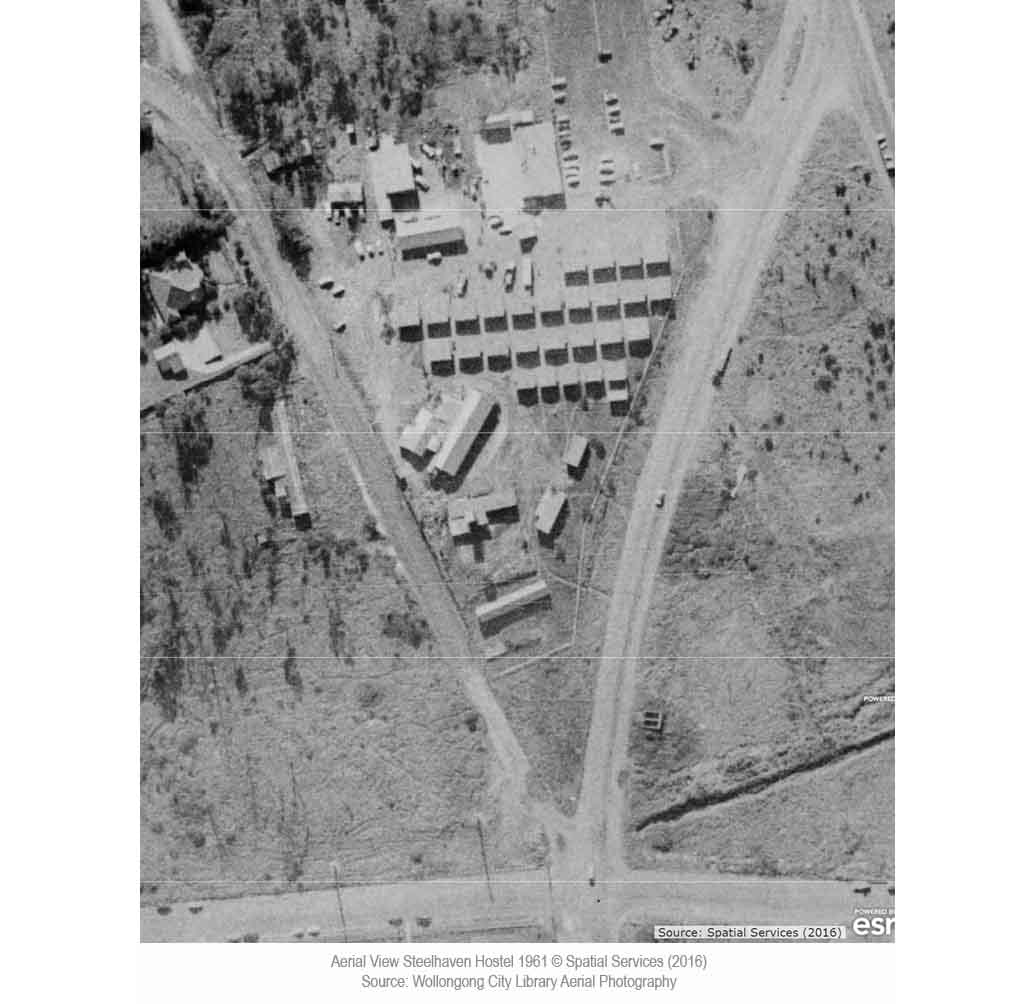
Compared to Karingal Hostel the accommodation standard of Steelhaven was very poor. In fact, Steelhaven attracted a lot of criticism about its poor standard of accommodation, more from unions than its occupants. As early as March 1950, union leaders of the district were demanding to be allowed to inspect the living conditions at Steelhaven Hostel with reports of primitive facilities of the lavatories and washing facilities. Steelhaven Hostel consisted of 25 huts and 28 two-man tents. The huts measured 15 square housing 6 men each and with the men working different shifts it made living in at Steelhaven quite difficult. One disgruntled prospective (non-migrant) AI&S employee in January 1950 described the hostel at Steelhaven as consisting of a collection of huts and tents but as he didn’t like the idea of being crowded in with five other persons he elected not to stay and could understand why AI&S were experiencing labour shortages if Steelhaven Hostel was the standard of accommodation on offer.
Steelhaven Hostel kitchen and dining room was of a style that was typically used by the Army. Even though AI&S managed Steelhaven, the catering was done by an outside contractor. Cooking was done using coke fuel which made the temperature conditions in the kitchen during summer very uncomfortable.
The accusations of poor standards were denied by AI&S.
By February 1951, there was a recording of 200 men living at Steelhaven Hostel, compared to the 120 at Lysaghts Hostel, 390 at Karingal and 370 at Unanderra Hostel.
In September 1954, the Zone Committee asked AI&S to remove Steelhaven Hostel as it had been reported to the Zone Clerk that Steelhaven was not occupied and that AI&S did not propose to use the hostel buildings, but the buildings remained.
In April 1959, Steelhaven Hostel was leased to Electric Power Transmission Pty Ltd (EPT). EPT was formed in Australia in 1951 in answer to NSW Premier Joe Cahill’s agreement with Italian company Societa Anonima Elettrificazione SpA to construct steel transmission lines in answer to helping end the post-war blackouts. EPT started with twenty five SAE employees, a priest and two SAE engineers. EPT would bring out more Italian employees as well as recruit within Australia. It was another major employer of migrants, mostly Italian, and was responsible for many major infrastructure projects including but not limited to Tallawarra Power Station in Dapto and the Snowy Mountain Hydro Electric Scheme. EPT would use Steelhaven Hostel to accommodate their workers until about August 1969. They also added additional buildings to Steelhaven. EPT would also go on to build their own employee accommodation in Unanderra.
Steelhaven Hostel was set down for demolition three months from 30 May 1969. At the time of its demolition it was in a poor, completely run-down state. Of the 25 disused huts that remained, most of the windows, doors and walls were damaged. The grounds and underneath the huts were full of rubbish and weeds. The outside walls of the huts had never been installed and the inside walls were as thin as cardboard without a lick of paint on them. At the time of its impending demolition, 24 employees of EPT were still living in some of the huts while they waited for the new EPT Hostel on Five Islands Road Unanderra to be finished within those three months. Once EPT departed Steelhaven Hostel, EPT destroyed the buildings it had built and returned the property to AI&S who intended to demolish the remaining buildings and clean up the area. AI&S at this time had no immediate plans to use the Steelhaven Hostel site.
On Saturday, 6 September 1969, commencement of the demolition of four huts, kitchen and the dining hall from Steelhaven Hostel was undertaken by a group of volunteers from the South Pacific Electric Railway and Australian Electric Transport Museum. AI&S had donated the buildings to the Museum. On that first weekend of the demolition, six tons of corrugated iron and timber were trucked to the Museum. When demolition of the kitchen section was underway the volunteers found this area to be reeking of putrid oil and grease that coated all surfaces, as well as rat’s nests, a dead cat and cockroaches by the hundreds. Perhaps the concerns about the standard of living at Steelhaven Hostel were warranted after all. Most of the timber from the kitchen was burned which meant only a small amount was salvageable. The floorboards of the dining hall were found to be brittle and could not be extracted successfully. The remaining iron and salvaged timber filled up two semi-trailer loads as well as 500 bricks in a volunteer’s truck all of which were transported to the Museum.
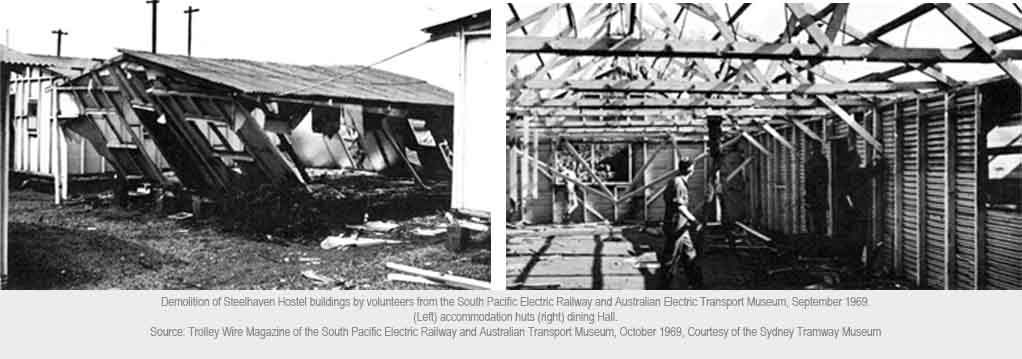
The site of the Steelhaven is still largely vacant with some BlueScope Steel buildings located nearby. There is no evidence that Steelhaven ever existed.
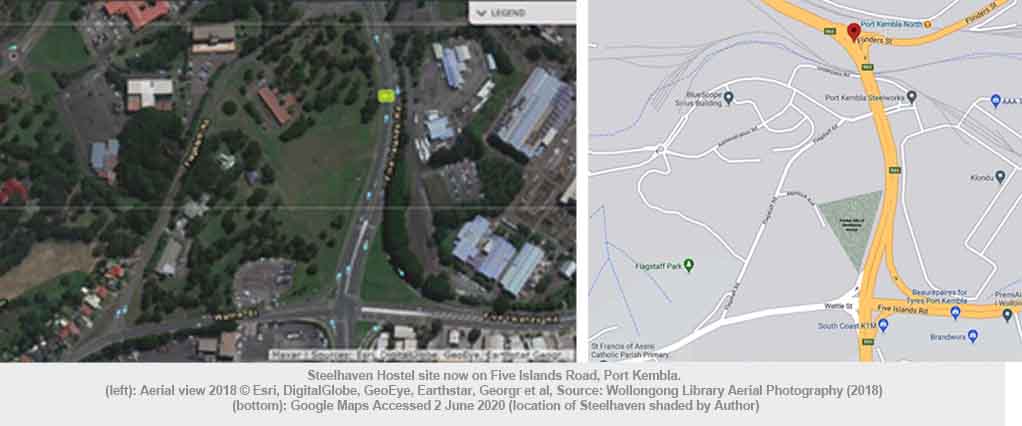
But Steelhaven Hostel is more than just history and buildings. Real people, who either chose to come to Australia or Australia was chosen for them, lived there. Who were they? Below is one list that was compiled during a visit in May 1950.
Steelhaven Hostel Residents ca. 1949-1950 (source: BHP archives)
Elezovic MUHUREM, Jan PLESKACEWICZ, Jan BIL, Wojcieck YASINSKI, Grzegor JAZYK, Walter HERRMANN, Mieczylaw DABROS, Jkob TKACZEWSKI, Joseph NOVOTNY, Eugieniosz MIKUTOWSKI, Kazimierz MANKOWSKI, Tadeusz SKORA, Stanislaw MINOR, Grzegor JASINSKI, E. PLOCIENNIK, Wladislaw KUCZALSKI, Mikolaj STEFANOWICZ, Victor JANIK, Vlastimir DIMIC, Jan BAZAREWSKI, Feliks SWIATKOWSKI, Zozis DABROWKSI, Wkladyslaw BUCZMA, M. GZMIGEBSKYJ. Vazeo SOCRAT. Anton HASIUK, Wladislaw DOMANSKI, Wieslaw SZOTA, Wladyslaw SUSMAIR, Joseph GOERES, Dmytro IHNAT, Wladyslaw SZCZERBA, Stefan KOVACEVIC, Gregor RUDYK, Stefan GRYPA, Lazzaro CORREJ, Stefan BAKAJ, Jan KOSTUSIK, Luigi BODINI, Gorg HOLOWINSKI, GEBSKI, Endel OTS, Micheal ZYBERT, SULES, Peter SZILASSY, Roman MASTROWICZ, Alojzy PITURA, Josef KANCIUKAITIS, Bronislaw POLEC, Karlis ANSONS, Nitold JAKIMOWICZ, Wladimir KRAWTCHENKO, Walentyn CZDRNOBEY, Anton SZYMANSKI, Jan LOTYCZUK, Mikola DMETRESCHYN, MILEK, Edward ADOMAITYS, Kasimir KOWALSKI, Edward RUTULIS, Kazimierz MOZDSEN, Lonard ZAJKOWSKI
Men were unaccompanied, some were single while many others were separated from their families who were accommodated at the following Hostels: Scheyville, Bathurst, Cowra, Greta, Parkes, Bowral, Uranguinty.
The history of Steelhaven Hostel took place on Dharawal Country whose traditional custodians remain the First Nations People – Always was Always will be.
The Migration Heritage Project acknowledges the First Nations people as the traditional owners and custodians of the land upon which the stories of migration have been explored, documented and recorded.
The land upon which Steelhaven Hostel was located is also significant to the early white settlement history of the Illawarra as as it was one of the first five land grants. The land was granted to David Allan which he named “Illawarra Farm”. The land would eventually become part of the Wentworth Estate called ‘Five Islands Estate’. In March 1921 Charles Hoskins purchased 400 acres of the Five Islands Estate for his Port Kembla works. This area would become the site of No 1 Steelworks and the Steelhaven Hostel.
The Migration Heritage Project acknowledges the First Nations people as the traditional owners and custodians of the land upon which the stories of migration in this newsletter have been documented, recorded and explored.


